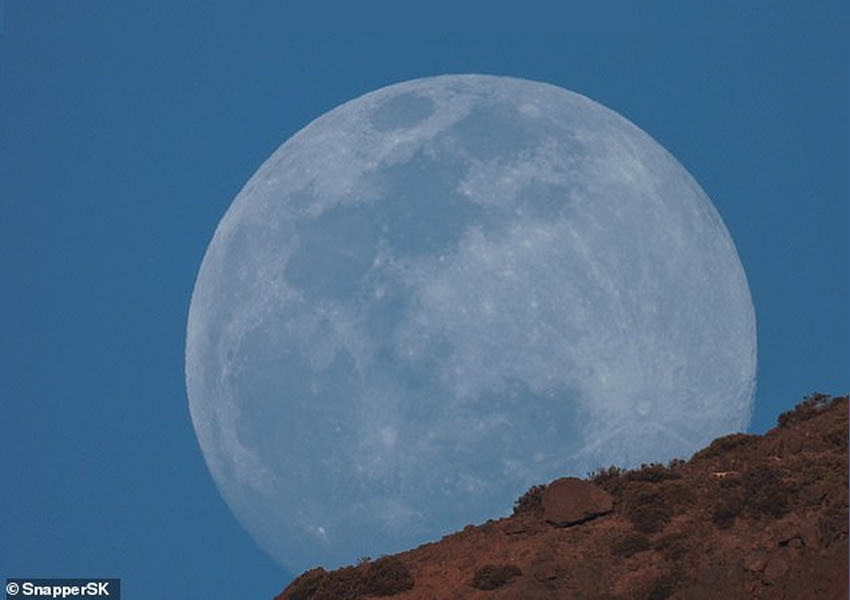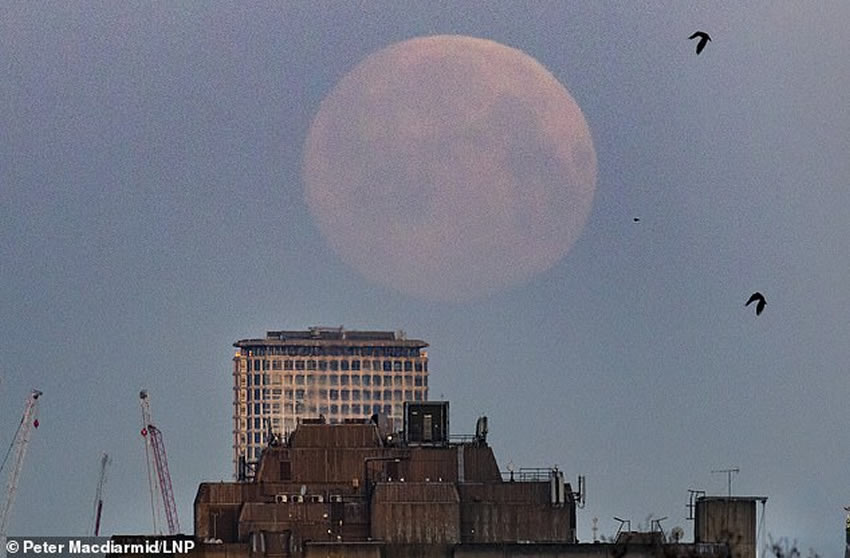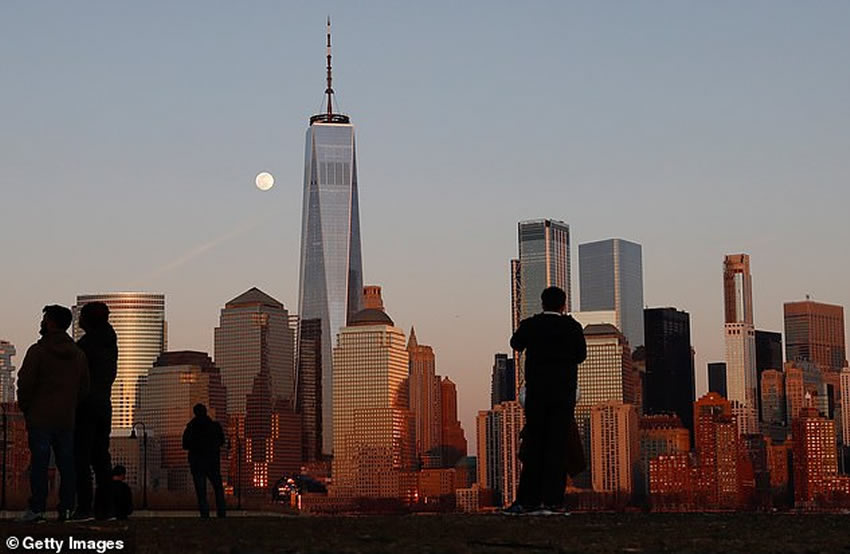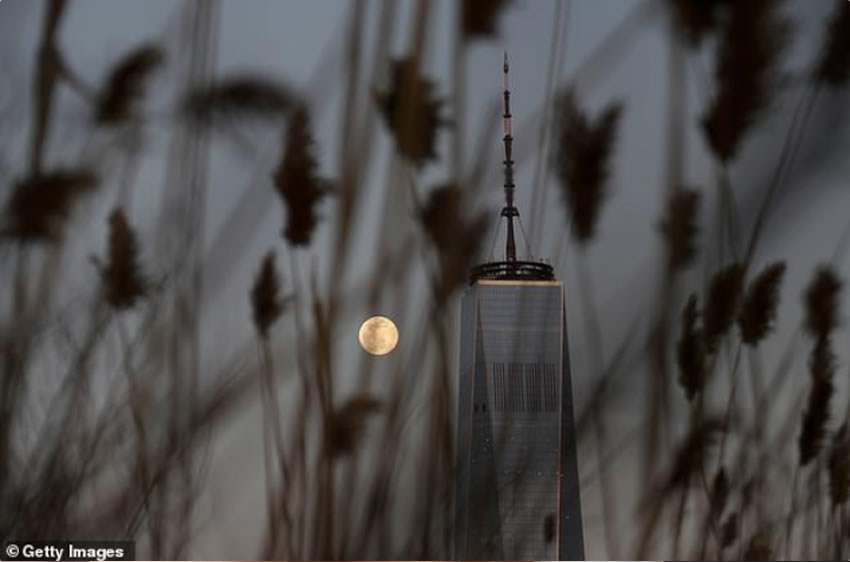This weekend the first supermoon of the year will be visible, named the Worm Moon, reaching its biggest and brightest in the night sky on Sunday.
The Worm Moon is named for the earthworms that begin to appear in March, when the soil begins to warm up, bringing robins and other birds for the start of spring.
It won’t be as spectacular in the UK as it could be as forecasts for the weekend point to cloudy skies, that will obscure the magnitude of Earth’s natural satellite.
The clocks change to British Summer Time, moving an hour ahead on Sunday morning, with the moon first rising above the horizon at 19:06 BST, and the point it will appear largest will be 19:48 BST.
It should appear full through until Tuesday morning, according to NASA.
The best time to photograph the Moon is at it rises. When the Moon is low on the horizon the atmosphere makes it appear even larger, astronomers suggest.
This shows the first Supermoon of 2020 as it rises above Tenerife’s Teide National Park. The Worm Moon can be viewed from Sunday Evening through to Tuesday morning
The near full supermoon sets over London. Also know as the Worm Moon, taken in 2020
What is a supermoon?
- A ‘supermoon’ appears to us as a larger-than-usual Moon in our night sky.
- A supermoon takes place when the moon is full and its orbit at its perigee point is closest to Earth.
- As the moon orbits in an ellipse its closest point – the perigee – will come very close to earth. The farthest point of the ellipse is called the apogee.
- When a full moon appears at perigee, the moon looks brighter and larger than a regular moon, hence the nickname supermoon.
A supermoon occurs when the full moon nearly coincides with perigee – the point in the orbit of the moon at which it is nearest to the Earth.
At perigee a supermoon can appear as much as 14 per cent larger and 30 per cent brighter than normal, when viewed from Earth, depending on the time of year.
Full moon names were historically used to track the seasons by various Native American tribes, and therefore are closely related to nature.
If possible, the best time to view the full moon is when it is close to the horizon, due to an optical illusion that makes it appear bigger due to its relative size compared to buildings, trees and other objects in the foreground.
Astronomers advise photographers to download apps and maps to track the progress of the moon across the sky, in order to make sightings easier.
Dr Daniel Brown, an astronomy expert at Nottingham Trent University said supermoons often encourage people to go out and take their first steps in astrophotography thinking the moon will be much larger than normal.
‘However, in reality supermoons are never huge at all so don’t get fooled in thinking that you can see it being larger than usual,’ he said.
‘The so-called “moon illusion” will make the moon appear much larger than it really is, when it is close to the horizon, but that happens for any full moon or moon phase you observe,’ he said,’ adding ‘go out there and enjoy spotting the moon.’
Different publications use slightly different thresholds for deciding when a full moon is close enough to the Earth to qualify as a supermoon.
For example, this year March is only ‘borderline’ a supermoon, with moons in April, May and June being much closer to the Sun than this month’s full moon.
‘The full Moons in April and May are nearly tied as the closest full Moons of the year,’ NASA explained in a blog post.
‘The full Moon on May 26, 2021, will be slightly closer to the Earth than the full Moon on April 26, 2021, but only by a slim 0.04%!’
The moon at 99.0 per cent rises behind One World Trade Center and the skyline of lower Manhattan in New York City at sunset on March 8, 2020
A Sunday evening almost full moon at 97.6 per cent, as it sets behind the Statue of Liberty in New York City
The moon at 99% rises behind One World Trade Center and the skyline of lower Manhattan in New York City at sunset on March 8, 2020
UPCOMING STARGAZING EVENTS
- April 12: New Moon – take advantage of a dark night sky to see the planets
- April 22 & 23: Lyrid Meteor Shower – this show of meteors will reach its annual peak
- April 27: Pink Full Moon – will be a Super Moon this year and 30% brighter than usual
- March – April: Constellation of Orion visible in the night sky
Lockdown lethargy has seen people look to the stars for inspiration, with many taking up astrophotography as a new hobby, and with nothing more than a smartphone it is possible to capture stunning images of the moon.
Wex Photo Video, an online photography service, said they saw a 260 per cent increase in traffic to their astronomy section since the start of lockdown in 2020.
While the Super Worm Moon will provide a good opportunity to photograph our natural satellite, experts predict the April and June moons will be more impressive.
Some regard the April moon not the March moon, as the first supermoon of 2021, including Chris Grimmer, an astrophotographer for Wex.
‘April’s Full Moon is traditionally known as the Pink Full Moon. This year, it’s also a Super Moon, so it will look a little larger than a usual Full Moon,’ he explained.
‘This Supermoon brings the Moon to approx. 223,000 km from earth, roughly 35,000 kms closer than at Apogee. This results in it appearing 30% brighter than normal,’ which is the upper end of how much brighter it can get.
Before technology, the moon could be used in this way to estimate time of month/year as a lunar cycle almost mirrors our monthly cycle.
‘The best time to photograph the Moon is at it rises. When the Moon is low on the horizon the atmosphere makes it appear even larger and often with an orange/red hue,’ he said.
‘This also allows you to capture the Moon with objects in the foreground, allowing you to obtain some very striking photos.’
FULL MOON NAMES AND THEIR MEANINGS
- January: Wolf Moon because wolves were heard more often at this time.
- February: Snow Moon to coincide with heavy snow.
- March: Worm Moon as the Sun increasingly warmed the soil and earthworms became active.
- April: Pink Moon as it heralded the appearance of Phlox subulata or moss pink – one of spring’s first flowers.
- May: Flower Moon because of the abundance of blossoms.
- June: Strawberry Moon because it appeared when the strawberry harvest first took place.
- July: Buck Moon as it arrived when a male deer’s antlers were in full growth mode.
- August: Sturgeon Moon after the large fish that was easily caught at this time.
- September: Corn Moon because this was the time to harvest corn.
- October: Hunter’s Moon after the time to hunt in preparation for winter.
- November: Beaver Moon because it was the time to set up beaver traps.
- December: Cold Moon because nights at this time of year were the longest.











